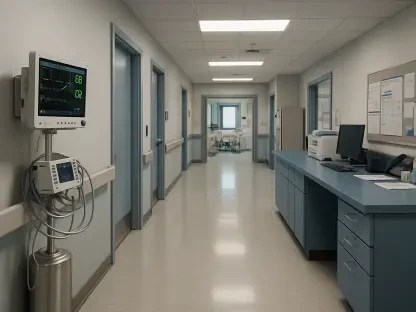Imagine a world where individuals battling severe chronic obstructive pulmonary disease (COPD) can receive top-tier medical care without stepping foot outside their homes, especially after a grueling hospital stay due to a flare-up. A groundbreaking study published in BMC Pulmonary Medicine reveals how telemedicine is reshaping healthcare for patients with advanced COPD, specifically those in GOLD stages 3-4. This innovative approach not only enhances quality of life (QOL) but also improves critical aspects like inhaler technique and fosters a sense of empowerment through self-management. For many, the challenges of frequent in-person follow-ups—whether due to mobility constraints or geographic isolation—are significant barriers to consistent care. Telemedicine emerges as a vital solution, bridging the gap between patients and healthcare providers through virtual platforms. This development signals a shift in chronic disease management, offering hope and accessibility to those who need it most, while potentially easing the strain on overburdened medical systems.
Revolutionizing Care with Virtual Check-Ins
Telemedicine is proving to be a transformative force in managing severe COPD, as demonstrated by a recent randomized clinical trial involving 74 patients. These individuals, recently discharged after a COPD exacerbation, were split into two groups: one receiving follow-up care through video calls at specific intervals (10 days, 1 month, and 3 months), and the other adhering to traditional in-person outpatient visits. The telemedicine group benefited from assessments of vital signs, respiratory symptoms, and medication usage during these virtual sessions. Healthcare providers could offer immediate advice and interventions, a level of responsiveness often harder to achieve with scheduled clinic appointments. This consistent digital connection ensured that patients remained under close supervision without the physical and emotional toll of travel, highlighting a key advantage over conventional methods that often struggle with logistical hurdles.
The impact of these virtual check-ins extends beyond mere convenience, creating a supportive framework for patients with limited access to healthcare facilities. Many with severe COPD face challenges in attending regular appointments due to fatigue, breathlessness, or distance from medical centers. Telemedicine eliminates these barriers by bringing care directly into the home, ensuring that follow-ups are not missed due to external constraints. Additionally, the real-time interaction during video calls fosters a stronger patient-provider relationship, as concerns can be addressed promptly without the delays inherent in waiting for an in-person slot. This approach not only maintains continuity of care but also reassures patients that help is just a call away, potentially reducing anxiety associated with managing a debilitating chronic condition on their own.
Enhancing Daily Living for COPD Patients
Among the most compelling outcomes of the study was the remarkable improvement in quality of life for those in the telemedicine group. Measured through the COPD Assessment Test (CAT) questionnaire, their median score dropped to 9 after three months, compared to a score of 18 in the control group receiving standard care. This significant difference reflects a substantial reduction in the burden of symptoms like shortness of breath and fatigue, allowing patients to engage more fully in daily activities. Such progress indicates that regular remote monitoring can have a profound effect on how patients perceive their health, offering them a renewed sense of normalcy and control over a condition that often feels overwhelming.
Further analysis of the data shows that the telemedicine group experienced a steady improvement in CAT scores over time, suggesting that consistent virtual engagement with healthcare providers plays a crucial role in mitigating the impact of COPD. Unlike sporadic in-person visits, which may leave gaps in care, the structured follow-up schedule of video calls ensures ongoing support and timely adjustments to treatment plans. This sustained interaction helps address subtle changes in condition before they escalate into severe exacerbations requiring hospitalization. For patients with advanced COPD, where every day can be a struggle, this proactive approach through telemedicine offers a pathway to better manage their illness, ultimately enhancing their overall well-being in ways traditional care models often cannot match.
Improving Critical Skills via Remote Guidance
A pivotal aspect of COPD management lies in the correct use of inhalers, and telemedicine has shown remarkable success in this area. By the end of the three-month study, an impressive 91.4% of patients in the telemedicine group demonstrated proper inhaler technique, compared to only 65.7% in the control group. The key difference stemmed from the ability of healthcare providers to observe and correct usage in real time during video calls. This immediate feedback loop allowed for adjustments that are often overlooked during brief in-person consultations, ensuring that patients maximize the benefits of their medication with each use, which is critical for controlling symptoms and preventing flare-ups.
While the improvement in technique was striking, the study also noted a trend toward better inhaler adherence in the telemedicine group, with 70.6% sticking to their schedules compared to 55.9% in the control group, though this difference did not reach statistical significance. This suggests that while frequent reminders and virtual encouragement help, additional strategies might be necessary to cement consistent medication habits. The visual and verbal reinforcement provided through telemedicine offers a unique advantage, yet it also underscores the complexity of behavioral change in chronic disease management. Future efforts could focus on integrating more personalized digital tools or alerts to further support adherence, building on the foundation that telemedicine has already established for skill-building in patients with severe COPD.
Fostering Patient Confidence in Digital Care
Patient feedback on telemedicine revealed a high level of satisfaction, with 89% of participants in the virtual care group expressing a preference for continuing with this model over traditional visits. The ease of accessing healthcare providers from the comfort of home, without the stress of travel or long waiting times, was frequently cited as a major benefit. This overwhelming approval points to a growing acceptance of digital solutions among those with chronic conditions, particularly for individuals with severe COPD who often face significant physical limitations. The convenience of virtual follow-ups translates into a more positive healthcare experience, which is essential for long-term engagement with treatment plans.
Equally noteworthy is that 83% of the telemedicine group reported minimal or no anxiety about remote consultations, a testament to the sense of security fostered by regular digital contact with medical professionals. For many, the ability to discuss symptoms or concerns without time constraints during video calls created a reassuring environment, unlike the often rushed nature of in-person appointments. This reduced anxiety can play a significant role in mental health, an often overlooked aspect of managing a chronic illness like COPD. By making healthcare more approachable and less intimidating, telemedicine not only addresses clinical needs but also supports emotional well-being, paving the way for a more holistic approach to patient care in the digital age.
Alleviating Pressures on Healthcare Infrastructure
Telemedicine’s benefits extend beyond individual patient outcomes, offering substantial relief to strained healthcare systems. By significantly reducing the need for physical clinic visits, this approach optimizes resource allocation, shortens wait times, and cuts costs for both patients and providers. For those with severe COPD, who require frequent monitoring to prevent exacerbations, virtual care ensures that medical attention is delivered efficiently without overloading facilities. This is particularly crucial in areas with limited access to specialized respiratory care, where telemedicine can bridge gaps and ensure that patients receive timely interventions without burdening local infrastructure.
Moreover, the scalability of telemedicine presents an opportunity to rethink how chronic disease management is structured within broader healthcare frameworks. With the potential to handle a larger volume of follow-ups remotely, medical systems can redirect in-person resources to acute cases or emergencies, enhancing overall efficiency. The study’s findings align with emerging trends in healthcare delivery, where digital tools are increasingly seen as vital for addressing systemic challenges. For patients in remote or underserved regions, telemedicine stands as a beacon of accessibility, ensuring that high-quality care is not dictated by geography but by innovative technology that prioritizes patient needs above logistical constraints.
Paving the Way for Future Healthcare Solutions
Reflecting on the study, it became evident that telemedicine had delivered measurable improvements in quality of life and inhaler technique for severe COPD patients over the three-month period following hospital discharge. The significant drop in CAT scores and the high rate of correct inhaler usage in the virtual care group underscored the clinical value of remote interventions. High satisfaction levels among participants further affirmed the acceptability of this model, while the reduction in clinic visits pointed to substantial relief for healthcare systems. Moving forward, the focus should shift to integrating telemedicine into standard COPD protocols, ensuring robust technical infrastructure and clear legal guidelines to protect data and access equity. Additionally, expanding research to diverse populations and longer follow-up periods could refine this approach, addressing adherence challenges and maximizing long-term benefits for chronic disease management.









